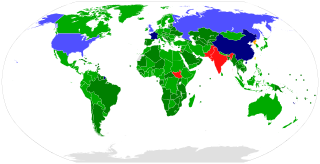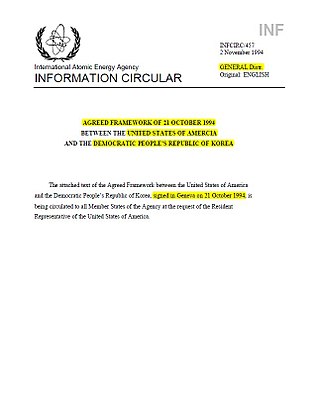
The International Atomic Energy Agency (IAEA) is an intergovernmental organization that seeks to promote the peaceful use of nuclear energy and to inhibit its use for any military purpose, including nuclear weapons. It was established in 1957 as an autonomous organization within the United Nations system; though governed by its own founding treaty, the organization reports to both the General Assembly and the Security Council of the United Nations, and is headquartered at the UN Office at Vienna, Austria.

The Treaty on the Non-Proliferation of Nuclear Weapons, commonly known as the Non-Proliferation Treaty or NPT, is an international treaty whose objective is to prevent the spread of nuclear weapons and weapons technology, to promote cooperation in the peaceful uses of nuclear energy, and to further the goal of achieving nuclear disarmament and general and complete disarmament. Between 1965 and 1968, the treaty was negotiated by the Eighteen Nation Committee on Disarmament, a United Nations-sponsored organization based in Geneva, Switzerland.

Nuclear proliferation is the spread of nuclear weapons, fissionable material, and weapons-applicable nuclear technology and information to nations not recognized as "Nuclear Weapon States" by the Treaty on the Non-Proliferation of Nuclear Weapons, commonly known as the Non-Proliferation Treaty or NPT. Proliferation has been opposed by many nations with and without nuclear weapons, as governments fear that more countries with nuclear weapons will increase the possibility of nuclear warfare, de-stabilize international or regional relations, or infringe upon the national sovereignty of nation states.

The Agreed Framework between the United States of America and the Democratic People's Republic of Korea (북미제네바기본합의서) was signed on 21 October 1994, between North Korea (DPRK) and the United States. The objective of the agreement was the freezing and replacement of North Korea's indigenous nuclear power plant program with more nuclear proliferation resistant light water reactor power plants, and the step-by-step normalization of relations between the U.S. and the DPRK. Implementation of the agreement was troubled from the start, but its key elements were being implemented until it effectively broke down in 2003.

The Nyongbyon Nuclear Scientific Research Center(녕변원자력연구소) is North Korea's major nuclear facility, operating its first nuclear reactors. It is located in Nyongbyon County in North Pyongan Province, about 100 km north of Pyongyang. The center produced the fissile material for North Korea's six nuclear weapon tests from 2006 to 2017, and since 2009 is developing indigenous light water reactor nuclear power station technology.
The nuclear program of Iran is an ongoing scientific effort by Iran to research nuclear technology. Iran has several research sites, two uranium mines, a research reactor, and uranium processing facilities that include three known uranium enrichment plants.

In the 1970s and 1980s, during the military regime, Brazil had a secret program intended to develop nuclear weapons. The program was dismantled in 1990, five years after the military regime ended. Brazil is considered to possess no weapons of mass destruction but does have some of the key technologies needed to produce nuclear weapons.

South Korea has the raw materials and equipment to produce a nuclear weapon. However, it has not opted to make one. South Korea has continued on a stated policy of non-proliferation of nuclear weapons since 2004 and has adopted a policy to maintain a nuclear-free Korean Peninsula. By contrast, North Korea has and is developing additional nuclear weapons.

Iran is not known to currently possess weapons of mass destruction (WMD) and has signed treaties repudiating the possession of WMDs including the Biological Weapons Convention, the Chemical Weapons Convention, and the Non-Proliferation Treaty (NPT). Iran has first-hand knowledge of WMD effects—over 100,000 Iranian troops and civilians were victims of chemical weapons during the 1980s Iran–Iraq War.
A nuclear fuel bank is reserve of low enriched uranium (LEU) for countries that need a backup source of LEU to fuel their nuclear reactors. Countries that do have enrichment technology would donate enriched fuel to a "bank", from which countries not possessing enrichment technology would obtain fuel for their power reactors.
This is the timeline of the nuclear program of Iran.

Libya pursued programs to develop or acquire weapons of mass destruction from when Muammar Gaddafi seized control of Libya in 1969 until he announced on 19 December 2003 that Libya would voluntarily eliminate all materials, equipment and programs that could lead to internationally proscribed weapons. This included weapons of mass destruction and long-range ballistic missiles.

Iran's nuclear program is made up of a number of nuclear facilities, including nuclear reactors and various nuclear fuel cycle facilities.
The International Conference on Nuclear Disarmament took place in Oslo on 26 and 27 February 2008. It was organized by The Government of Norway, the Norwegian Radiation Protection Authority in collaboration with the NTI and the Hoover Institute. The Conference, entitled "Achieving the Vision of a World Free of Nuclear Weapons", had the purpose of building consensus between nuclear weapon states and non-nuclear weapon states and about the importance of all the actions in the NPT.
President Adly Mansour announced on 7 November 2013 that Egypt was restarting its nuclear power program in El Dabaa; a deal was reached with the residents in which it was agreed that a residential area will also be built. The Egyptian minister of electricity, Ahmed Emam, has called the project "necessary" because of a small amount of renewable energy sources and not enough fuel.

International Atomic Energy Agency (IAEA) Safeguards are a system of inspection and verification of the peaceful uses of nuclear materials as part of the Nuclear Non-Proliferation Treaty (NPT), supervised by the International Atomic Energy Agency.
Views on the nuclear program of Iran vary greatly, as the nuclear program of Iran is a very contentious geopolitical issue. Uriel Abulof identifies five possible rationales behind Iran’s nuclear policy: (i) Economy, mainly energy needs; (ii) Identity politics, pride and prestige; (iii) Deterrence of foreign intervention; (iv) Compellence to boost regional influence; and (v) Domestic politics, mitigating, through 'nuclear diversion' the regime’s domestic crisis of legitimacy. Below are considerations of the Iranian nuclear program from various perspectives.

Nuclear Non-Proliferation Act of 1978, 22 U.S.C. § 3201, is a United States federal law declaring that nuclear explosive devices pose a perilous threat to the security interests of the United States and continued international progress towards world peace and the development of nations.
Material unaccounted for (MUF), in the context of nuclear material, refers to any discrepancy between a nuclear-weapons state's physical inventory of nuclear material, and the book inventory. The difference can be either a positive discrepancy or a negative discrepancy. Nuclear accounting discrepancies are commonplace and inevitable due to the problem of accurately measuring nuclear materials. This problem of inaccurate measurement provides a potential loophole for diversion of nuclear materials for weapons production. In a large plant, even a tiny percentage of the annual through-put of nuclear material will suffice to build one or more nuclear weapons.

The Republic of Kazakhstan, once a republic of the Soviet Union, was a primary venue for Soviet nuclear weapon testing from 1949 until 1989. Following the collapse of the Union of Soviet Socialist Republics (USSR) in 1991, Kazakhstan became the fourth-largest nuclear power in the world and hosted a considerably large weapon support infrastructure due to its reliance on the Soviet nuclear program as a means to develop its own local economy. Besides the nuclear program, Kazakhstan was also a prominent site of Soviet programs of biological and chemical weapons.











